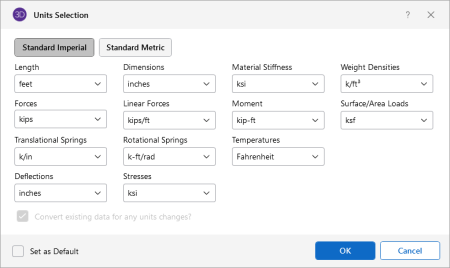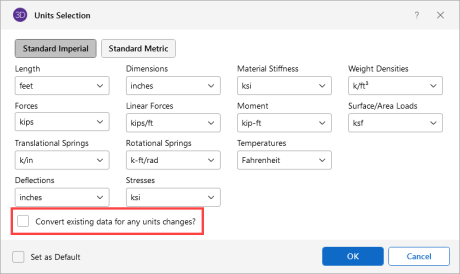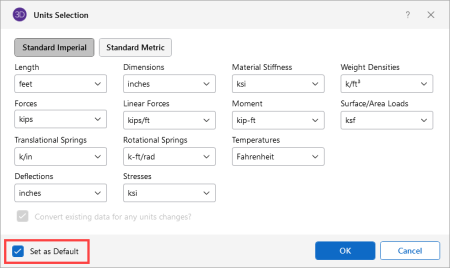Units
You can work with imperial (kips, inches, etc.) or metric (KN, meters, etc.) units, or any combination of the two. The current units appropriate for each data item are shown at the tops of the data columns in the spreadsheets and with the plot of values in the model view.
To change units:
-
Click the Units icon in the ‘Model’ section of the Home ribbon.
Click on image to enlarge it
The Units Selection window opens.
Click on image to enlarge it
-
Specify the units you want for each item in the drop down lists.
Standard units systems are preset and may be specified by clicking the Standard Imperial and Standard Metric buttons.
-
(Optional) Clear the check box for Converting Existing Data if you do not wish to convert values already entered (as shown in the following image).
Click on image to enlarge it
-
(Optional) Check the Set as Default box to save your selections as the default.
You can save any of the units as the default setting so that when you start a new model the information is already there. (as shown in the following image).
Click on image to enlarge it
-
Click OK to save your change and close the window.
Standard Imperial Units
This is the units system currently prevalent in the United States.
'Feet' are used for location entries such as
Standard Metric Units
This units system uses 'Meters' for location entries and 'Centimeters' for section property entries. Force units are in 'kN' (kiloNewtons), where 1 KN = 1000 Newtons. Stress units are in 'MegaPascals' (MPa), where a MegaPascal is 1,000,000 Newtons per square meter. Weight units are in 'Kilograms' and thermal units are in 'Degrees centigrade.
Units Specifications
The following are the unit specifications and their applications:
Unit Specifications Measurements and Usage
| Measurement | Usage |
|---|---|
|
Lengths |
Coordinates, |
|
Dimensions |
Shape Properties, Plate Thickness |
|
Material Stiffness |
E, G |
|
Weight Densities |
Material Density |
|
Forces |
Loads, Forces |
|
Linear Forces |
|
|
Moments |
Loads, Forces |
|
|
Plate/Shell Surface Loads, Area Loads |
|
Translational Springs |
|
|
Rotational Springs |
X Rot, Y Rot, Z Rot Boundary Conditions |
|
Temperatures |
Thermal Coefficient, Temperatures |
|
Deflections |
Deflections, Displacements |
|
Stresses |
Fy, Allowable and Actual Stresses |


